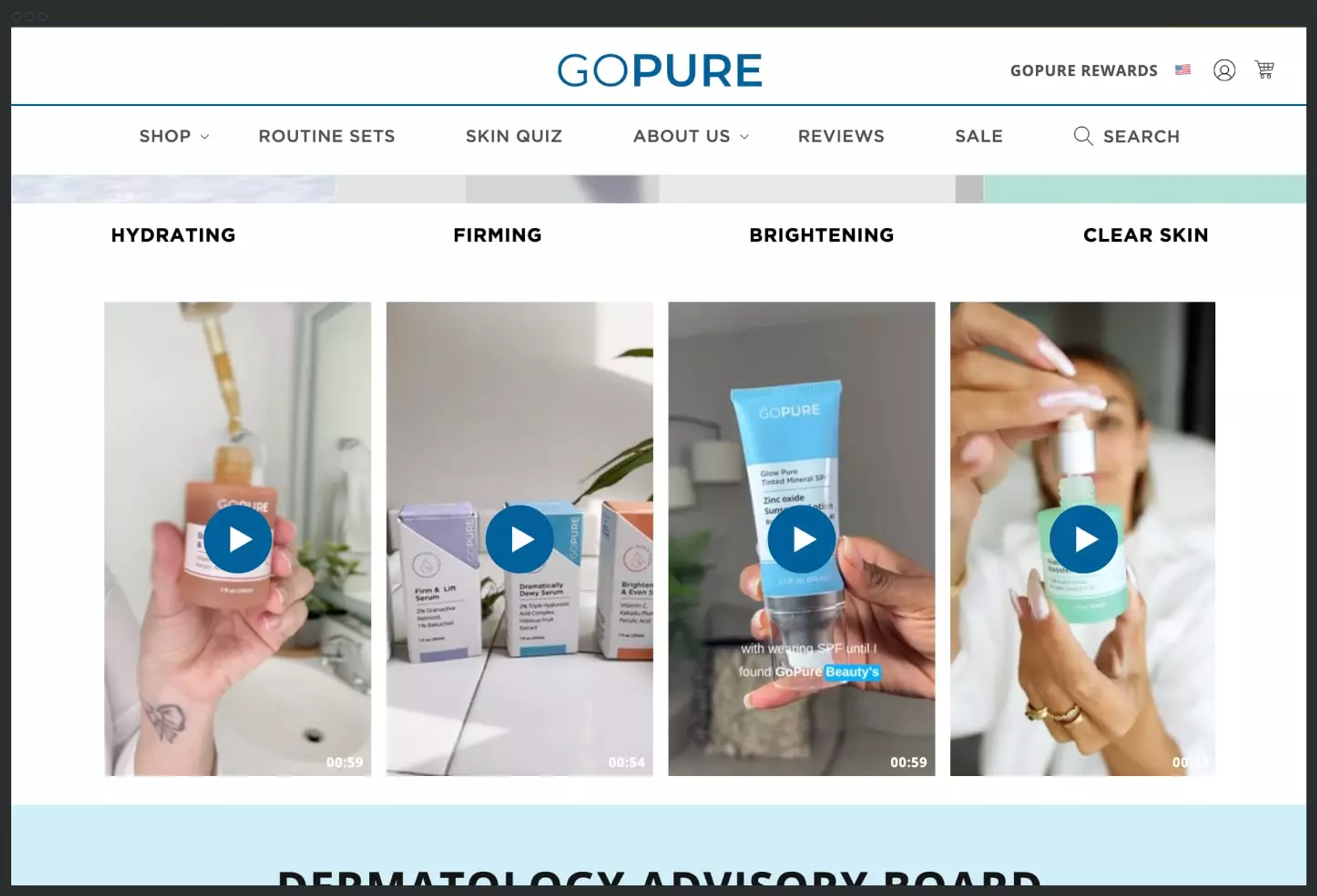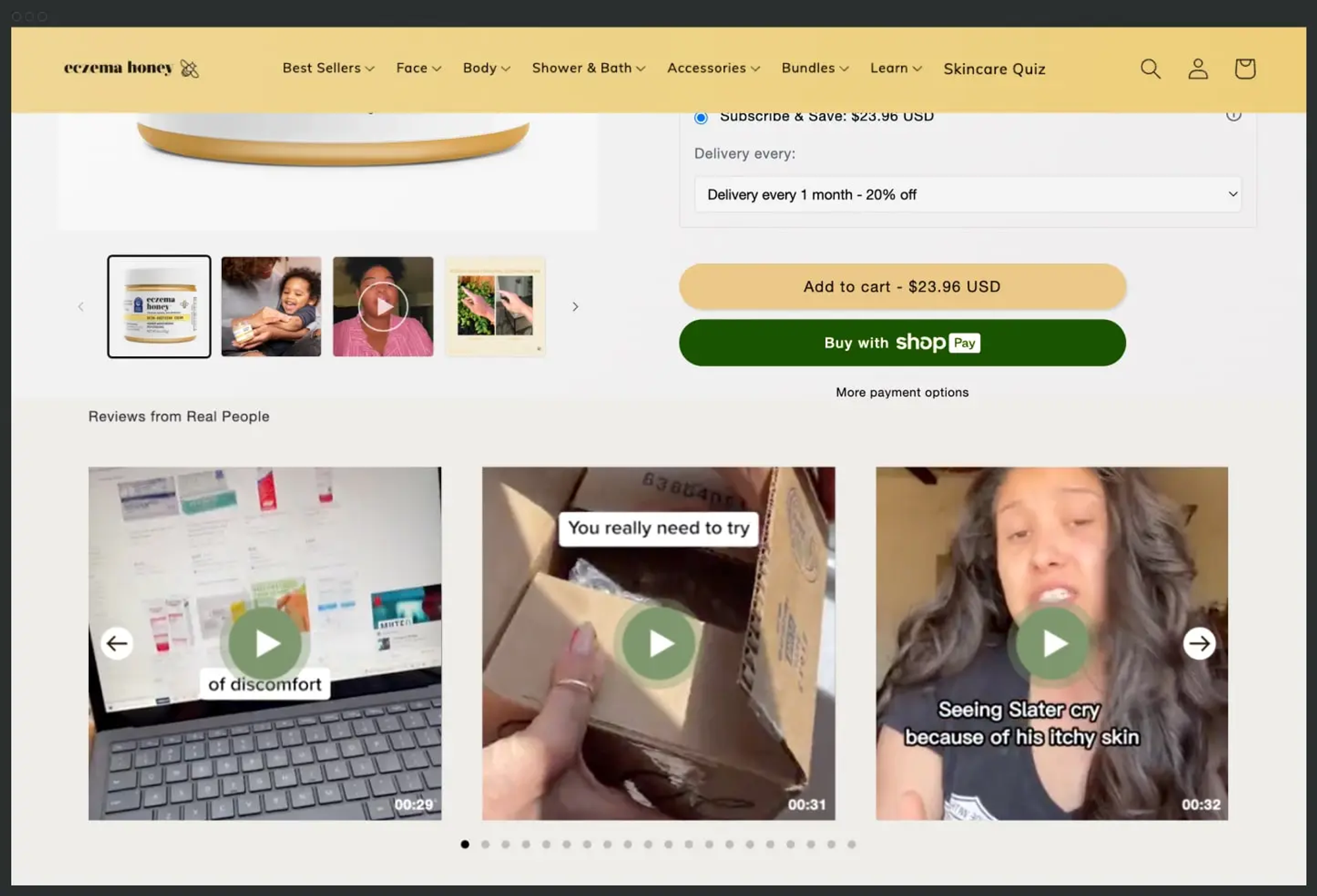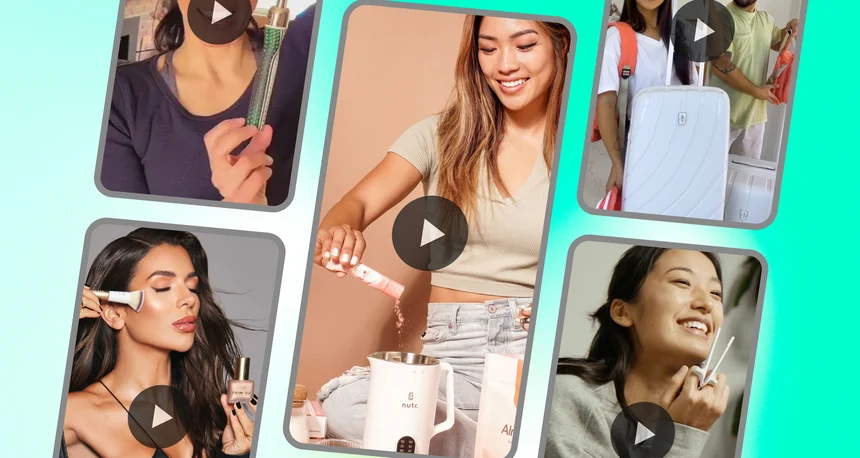Share
Every time I shop from a brand for the first time, I perform my due diligence by:
- Checking the brand’s reviews on their website/Google
- Scanning their social media channels for negative reviews
- Looking for videos that show the product in action
And I’m not the only one looking for products or UGC videos before buying from eCommerce brands.
Savvy shoppers want to know exactly what they’re buying and whether it’s worth the price. That’s why videos build confidence among your buyers and drive phenomenal sales.
But here’s the kicker: video marketing is only for big brands with a bigger budget. False.
eCommerce brands can leverage cost-effective video solutions to reach their audience through video marketing. Want to know how? Check out this guide to find actionable tips.
Why video marketing for eCommerce
Wondering whether you should really spend those dollars on video marketing? Let me explain how this investment will bring long-term returns for your eCommerce business.
A good video marketing strategy has many benefits for your brand, including:
-
Build visibility in new markets: One of the biggest benefits of video marketing, especially social media video content, is enhanced brand awareness. You can reach a global market through platforms like TikTok and Instagram. Plus, you can use video editing tools to effortlessly translate your content to any language!
-
Increase buyer confidence: Gone are the days when you could create a flashy image and run ads with it. Over-the-top promotional ads instantly repel today’s buyers. But you can capture people’s attention and gain their confidence with user-generated videos. Let your customers be the face of your brand and show your products to potential shoppers.
-
Maximize conversion rates: Embedding videos at the right touch points within your website can also boost audience engagement. The result? Users will spend more time browsing your products (and videos) before purchasing. That’s exactly why goPure experienced an average engagement rate of 12% when they added shoppable videos to different pages on their site.

-
Bring organic search traffic: Videos rank well on organic search. You can level up your SEO efforts with video marketing and gain extra visibility among newer audiences. Once optimized for the right target keywords, your videos can drive traffic from organic search queries. This builds awareness even among those who’d never heard of your company.
-
Create a brand differentiator: When done right, video marketing can become a moat for your brand. You can showcase your brand personality through your content and create a thriving community of interested shoppers. It’s a great way to stay top-of-mind for potential buyers and take an edge over your competition.
These are only five of the many ways in which you can win with video. So, let’s break down our step-wise framework for budget-friendly online video production.
The end-to-end video production workflow for eCommerce brands
We get it. Homegrown and bootstrapped businesses can’t pour all their earnings into video marketing. But the good news is you can drive ROI and increase revenue even with a scrappy video production strategy.
Here are our best tips to get started with eCommerce video marketing within your budget.
Step 1: Ideate and plan
On day 0, don’t even think about buying a camera or creating a fancy setup for the shoot.
Before getting into the nitty-gritty of video production, you have to determine your video’s purpose. Define what success would look like for this campaign—is it increase in website traffic, viral brand awareness, more email subscribers, or something else?
Identify and prioritize your goals for each campaign. Then, create customer segments to target with these videos. For each segment, you should know:
- Buyers’ pain points
- Their current solutions
- Their buying motivation
- Their preferences & aspirations
You can leverage social listening tools to get a pulse of your buyers. Keep an eye on what they’re saying about your competitors to understand what truly resonates with them.
This is also a good stage to think from the lens of video SEO. Research the keywords your target buyers are the most interested in, and plan to incorporate these keywords in your video titles, descriptions, file names, and more.
Pro tip: Plan for multi-channel distribution—website, emails, social media, etc.—and create a workflow to tailor the length, format, and overall content of your videos for each channel.
Step 2: Script and storyboard
The next crucial step is writing the script for your videos and visualizing this script through a storyboard. This is where you can start giving shape to your ideas and brainstorm what the actual output will look like.
Keep these three ideas in mind for creating a compelling video script:
-
Storytelling > selling: Nobody wants to be sold to. Buyers are looking for content they can relate to. So, instead of blatantly selling your products, create an interesting narrative to reel in your shoppers. You can create stories around people’s biggest challenges or show the impact of your product with user-generated content, like Eczema Honey.
Eczema Honey’s 200+ UGC videos embedded across their website share hundreds of real customers’ stories and show the actual performance of their products.
-
Write like your buyers talks: You can’t talk in GenZ slangs when creating videos for the older-generation customers. It’ll only create confusion and hurt your brand in the long run. So, deep dive into your buyer personas to speak their language in your videos.
-
Add visual + auditory cues: Scripting is the best time to add suggestions or notes for creating magic with audio and video editing. Make your videos jazzy and delightful with these cues added to your script.
Remember: this is the best time to collect feedback from different stakeholders. You can make necessary changes to fine-tune your narrative instead of wasting time once the video is under editing.
Step 3: Video setup
You’re ready to roll with your script and storyboard. All that’s left to do is create a good setup for shooting the video. This is where most eCommerce brands worry about emptying their wallet on expensive lights, premium cameras, and other equipment.
In reality, you can easily create a budget-friendly setup. You need:
- Good natural light in soft tones
- Plain background in your brand colors
- A tripod or a makeshift stand to support your phone
- A mic or audio source (in case you’re recording audio)
You can always play around with the frame and create several interesting combinations from a single setup. Once your setup is ready, do a few test shots and see whether the lighting is perfect and if you’re facing any problems in capturing the audio.
Step 4: Create and edit
The most effort-intensive step in the process is editing the video to give it the final look as visualized. You can try a bunch of video editing tools and pick what works best for your skill level and experience.
I’m sharing a few handy tips for making your video extraordinary with basic editing features:
-
Add text overlays: Clearly demonstrate your product’s value props with text overlays indicating different benefits. You can also add calls to action, nudging viewers to take the desired action.
-
Incorporate branding: Add your logo and brand colors to make sure your videos look fully brand-aligned. You can follow a specific color palette across the entire video.
-
Edit for pace and rhythm: You can add the slow-motion effect to a few clips and increase the pace for a few shots. This will make the final output more dynamic and engaging for viewers.
-
Clean the audio track: Unclear or poor audio quality can be a huge turn-off. Make sure your audio is clear and balanced by cleaning any background noises or unnecessary distractions.
You can also add captions to make your videos accessible to hearing-impaired viewers. Adding translated subtitles also gives you the opportunity to reach people across different regions.
Pro tip: Create a captivating hook in the first five seconds. Give people a reason to watch the video till the end with this hook!
Step 5: Optimize for distribution
The final step is to tailor your video for different platforms. For example, you can’t share the same video as Instagram on your email because the size will differ. Plus, you can post a video on TikTok and share the same one on Instagram.
So, you should spend extra time customizing your videos for each platform’s aspect ratios. Resize the original content and add some finishing touches to ensure your videos look neat.
The ultimate resource list for eCommerce video production
We’ve built this list of video production tools to create DIY videos on a budget. You can check out different tools for specific use cases. Find our 15 most recommended video marketing tools for eCommerce brands.
Free stock footage
- Pexels
- Unsplash
- Pixabay
- Videvo
- Coverr
- Mixkit
Royalty-free audio
- Incompetech
- Bensound
- Purple Planet Music
- Audio Library
- Jamendo
- FreeSound
Video editing tools
- Filmora
- VEED
- Biteable
- Animaker
- DaVinci Resolve
Once you’ve created the perfect videos, you can distribute them across different channels using Videowise.
Simply upload your content to Videowise and embed the videos on your website. You can also share them via emails or QR codes. Plus, you can create social media posts and ads with shoppable videos—all from a single platform!
Make eCommerce videos in five easy steps
Don’t have the budget to create studio-quality videos for your eCommerce store? No sweat!
You only need a little bit of creativity to create awesome videos and drive ROI through these campaigns. We’ve shared our 5-step video production framework for a low-budget strategy. It’s time for you to get back to the whiteboard and start creating.
And don’t forget to check out how industry-leading brands like TrueClassic, Apolla, and SOSU are leveraging video content to ramp up their revenue.
Share





.jpg?width=420&height=420&name=live%20shopping%20top%205%20fashion%20(1).jpg)